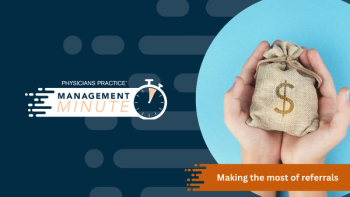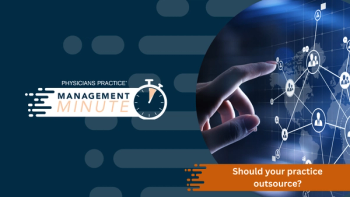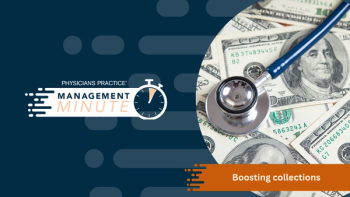
Get Paid the First Time
Look for patterns and common errors on your EOBs to boost collections
Do you tremble every time you open an explanation of benefits (EOB) -- wondering if payment will be in full, or whether there will be another reduction or outright denial? Like most practices, you cross your fingers and hope for the best.
In a perfect world, each line item on your EOB would be paid correctly -- meaning, at least in the amount of the payer's allowable. Alas, in the real world, many line items on EOBs indicate reduced payment or none at all.
No doubt you are constantly searching for strategies and tools to collect money faster and with less staff work and time. Why not start with that dreaded EOB? One strategy that will speed money into your practice is to analyze your EOBs to look for patterns and common errors, and then improve your systems based on the analysis.
These forms contain a trove of vital information, and if you know what to look for -- and how to put it to use once you find it -- you'll be able to collect more money with less work.
But before we talk about how to do it, let me offer an important caveat: The point of an EOB analysis is to cut the number of denials and reduced payments you get. It's not a replacement for a claims resubmission and appeals policy. Whether you analyze the data in your EOBs or not, every denial should be addressed individually, researched, and resubmitted. It seems unbelievable that practices will provide a medical service, bill for it once, and then write it off without complaint after a single denial, but this is what happens in many cases.
Speed your analysis
Denials, reductions in payment, and zero-dollar "payments" are usually the result of registration errors, mistakes in billing and coding, and processing errors. The first two are completely within your practice's control. And with the right data, you can address the last -- payer-processing errors -- at the time of recontracting.
What exactly should you be looking for when you examine your EOBs?
The first step is to identify the denials by reason code and sort the reasons into larger categories. Under registration errors, for example, you might include "name/insurance number do not match," or "beneficiary ineligible for date of service." If you are expecting payment electronically, make sure that full detail is captured for any denial codes.
Be specific. For example, instead of "Medicare write-off," list "Payment for this service included in payment for another service."
After collecting the data, you need access to it in a report form that is easy to understand. The task is to produce a report that shows both in detail and in summary form the number of claims and the dollar value of claims denied by payers in a given time period and sorted by reason.
How you do this is a function of the level of technology in your practice -- but don't despair if your technology level is low. Most practices can print a list of the denials by reason code and manually enter the data into a spreadsheet. And with just a little more programming work, the report from the billing software can be inserted into a spreadsheet.
You may also use report writer software or more specialized software designed specifically for reviewing EOBs. This is the most basic type of reporting, but it can be very valuable in learning the reasons for denials, solving problems systematically rather than one by one, and educating staff and physicians.
For example, say you find that you are consistently writing off for lack of medical necessity a certain lab test ordered by a certain physician. Armed with the information about how many times it happens each month and how much money the practice loses, you can bring it to the attention of the physician and the medical director. You are in a much stronger position to institute procedural changes.
Fix payer problems
The reimbursement analysts at Dartmouth Hitchcock Medical Center in Lebanon, N.H., use a report writer to gather information. The claims data are available to them via software that allows them to set specific criteria for the report they want to run.
For example, suppose they want to know how frequently a particular payer has been reducing its payments to the practice over the past two months, and on which services. No problem. They just set the software to flag any line item from that payer that comes in below the allowable amount built into the system. Once the data is extracted from the claims system into a database or spreadsheet, analysts like John Berlenbach, Jr., can sort the data by dollar amount, physician or department, type of service, modifier use, procedure code -- whichever criteria he feels is most important. This allows him to categorize denials and identify trends and issues.
Berlenbach reports that this information is valuable in improving internal processes and in negotiating with payers.
An advantage to sorting the data by payer is that it allows you to identify payer-processing issues, and bring them to the payer's attention. For example, anesthesia claims often need to be submitted differently for different payers. Identifying anesthesia denials by payer allowed Dartmouth to develop procedures to submit those claims according to individual payer requirements. An advantage to sorting the data by payer is that it allows you to identify specific payer-processing issues. Berlenbach says payers were willing to work with the practice to improve its claims processing, decreasing repetitive errors that cause incorrect denials. The analysts also recommend changes to payer contracts for renegotiation.
However, it doesn't take a sophisticated report writer to find problems. Jayne Lavariere, CPC, a coding and compliance specialist for Williamstown Medical Associates, a 30-physician, multispecialty group in Massachusetts, saved her practice thousands of dollars and corrected a systems problem with a single, simple report, a superior understanding of coding and billing rules, and knowledge of her practice procedures.
Here's how: after the practice implemented a process for charge capture by physicians with handheld devices, Lavariere ran a listing of surgical procedures with zero-dollar payments. She found a number of cases in which the general surgeons were not being paid for mastectomies. The mastectomies were being denied as part of a global period, when a biopsy was performed previously. The second surgery, the mastectomy, was submitted without a -78 modifier, which would have bypassed the claims-editing system and allowed the claim to be paid. Not only were these individual charges resubmitted, but Lavariere used the information to educate the physicians, edit claims prior to submission, and prevent the problem from recurring.
EOB analyzers
Some practices use software designed specifically to analyze data from their EOBs to manage their receivables more efficiently and effectively. A side benefit of such systems is the ability to collect EOB information with no additional work. Brett Butler, executive director of HeartPlace in Dallas, uses two of them, and he reports that his billing office never handles a paper EOB. Imagine that: no paper EOBs to copy, highlight, file, or find.
How does he do it? With help from two products. One is a collaboration between Third Millennium, Inc., of Atlanta, and Bank of America. All paper payments are sent to a lockbox at the practice's bank, and the accompanying documents scanned into a system developed by Third Millennium. The billing office receives indexed data about EOBs, not paper copies from the bank.
The second product is EOB Manager from Navicure, Inc., of Duluth, Ga. Many of HeartPlace's payments are received electronically, including from Medicare and its major commercial payers. When these payments are received, the reason codes for any denials are automatically captured in full detail and attached to the patient visit. This allows for both efficient claims follow-up and for detailed reporting.
About 60 percent of HeartPlace's payments come through the Navicure software. The system also gives it instant access to the EOBs, allowing analysts to print an EOB for a secondary claim, and sort through all data to identify problems.
The goal, says Navicure's Todd Walker, is "denial elimination, not denial management." That should be your goal, too.
Betsy Nicoletti is a speaker and practice management consultant specializing in coding education, billing, and accounts receivable, with more than 20 years of experience working with physicians. She can be reached at (802) 885-5641, betsy@vermontel.net, or
This articlke originally appeared in the May 2005 issue of Physicians Practice.
Newsletter
Optimize your practice with the Physicians Practice newsletter, offering management pearls, leadership tips, and business strategies tailored for practice administrators and physicians of any specialty.














